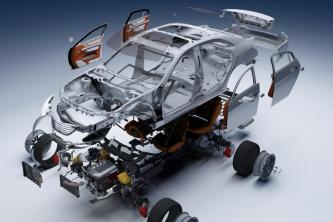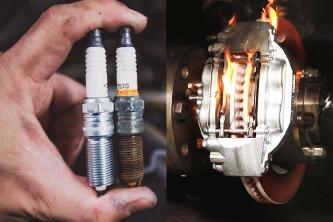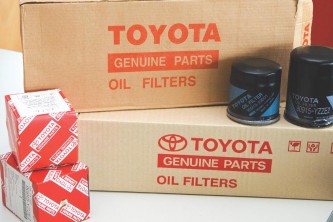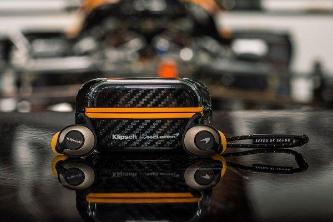mclaren aftermarket parts
Artikel Terkait mclaren aftermarket parts

Up to 90% cheaper! Sime Darby Motors offers clearance sale for BMW, Ford and Hyundai parts
Those on the hunt for genuine Ford and Hyundai car spare parts can rejoice as Sime Darby Motors and e-Commerce
Watch a Kia EV6 GT drag race against supercars from Lamborghini, Ferrari, Porsche, McLaren
out in a drag race against renowned performance cars like the Lamborghini Urus, Ferrari California T, McLaren
TRD kit among aftermarket options for Perodua D55L, sporty enough for you?
Being based on the exisiting Toyota Raize, an aftermarket TRD body kit is already available for those
Scissor-doors, 200 PS, and made by an auto parts shop! The ASL Garaiya
you’re a big fan of JDMs, you probably heard of Autobacs, that legendary one-stop Japanese auto parts
Philippines positioning itself as manufacturing base for Korean EV parts makers
Korean manufacturers, with the intention of attracting investments in the field of electric vehicle (EV) parts
Proton acknowledges spare parts shortage problem, reaches out to customers in need
hand, not just with supply issues of the very high in demand Proton X50, but also shortage in spare parts
2019 McLaren GT stuns Malaysia, the most practical supercar and lightest grand tourer
PS and 630 Nm of torqueSpeed, agility and practicality aren’t mutually exclusive as proven by McLaren
Proton vendors urge for exemptions for the automotive parts manufacturing industry
impending lockdown, the Proton Vendors Association (PVA) has urged the government to exempt automotive parts
Fix for Proton’s after-sales parts supply shortage underway, IT problem the cause
been waiting for months to get parts for their accident-damaged Proton cars.
GR Parts and Modellista versions of the all-new 2021 Toyota Harrier leaked!
outlets.This is how the all-new Toyota Harrier looks like without any bodykitToyota Harrier galleryGR Parts
Toyota keeps classic Supras on the road with GR Heritage Parts project
Toyota will be remaking spare parts for their classic Toyota Supra (A70 and A80) and reselling them in
McLaren designer says the world needs more red Mazdas, pens this
Rendering by João Dias on InstagramJoao Dias, the Principal Exterior Designer at McLaren since
Interested in a McLaren? The showroom awaits you at Glenmarie
The McLaren GT was launched in conjunction with the opening of the McLaren Kuala Lumpur showroom in Glenmarie
NISMO Heritage Parts adds new R32, R33, R34 Skyline GT-R parts to lineup
Nissan Motorsports International (NISMO) announced that they will be remanufacturing genuine replacement parts
Rejoice because your Small Little Kancil will still have parts!
Good news to old Perodua model owners because Perodua has just made body parts much easier to access!
Toyota GR Sport models to be launched in Malaysia soon?
First GR Garage to operate outside of Japan Genuine aftermarket tuning parts for all Toyota models GR
VW Group opens regional parts distribution hub in Malaysia
Volkswagen Group has opened a new regional parts distribution centre in the Port of Tanjung Pelepas,
80% discount for Hyundai and Ford spare parts at SpareXHub's clearance sale
SpareXHub, a stockist of geniune spare parts, is having a special clearance sale with up to 80 percent
Iconic Gulf livery makes F1 return with McLaren; Same livery will adorn McLaren 720S
The McLaren F1 team will bring the iconic powder-blue neon orange stripe Gulf livery back to the sport
All-new 2021 McLaren Artura revealed; 3.0L V6 hybrid, 680 PS/720 Nm, 8-speed DCT with E-diff
Built from the ground up, the all-new 2021 McLaren Artura replaces the McLaren 570S.
Review Post mclaren aftermarket parts
Shhhh, don't tell him. Also, be sure to research your aftermarket parts thoroughly, people! 🗑🥁👀 #SoulSpeed #Porsche #GT3RS #Corvette #McLaren #performanceshop #garage #tech #alignment #brakes #wheels #tires #maintenance #upgrade #aftermarket #autorepair #autoshop #trackprep… https://t.co/UqBm4alttk
Samgetrude Auto LTD is McLaren independent Spare parts Importer . We offer OEM McLaren spare parts along with aftermarket options and accessories as https://t.co/N8zXkgGmsK us @ https://t.co/0jtiLzs2kT WhatsApp +233555957473 We deliver to Ghana🇬🇭🇬🇭🇬🇭 and Sub-sahara https://t.co/gn7A8ir768
#McLaren 720S aftermarket takes new route with #3dprinting parts from 1016 Industries https://t.co/zxr9QvatZ1
🎶My my, how can I adjust you? Mamma mia, is your shock blown again? My my, time to replace those parts too.🎶 #SoulSpeed #Porsche #GT3RS #Corvette #McLaren #performanceshop #garage #tech #alignment #brakes #wheels #tires #upgrade #aftermarket #abba #bmw #Lamborghini #mammam… https://t.co/k6bN0hjVAw
Dope McLaren 720S 🎃 (via: @raw.shoots) . . . . Visit Us👉 https://t.co/UCX4U30pcD For All Your OE And Aftermarket Auto Parts As Well As Car/Truck Accessories 🏁🏎 Use Discount Code: “RACE2” For 15% Off Any Item In Stock! Free Shipping On All Orders! SHOP NOW!🏁🏎 #mclaren #720S https://t.co/mhqn1rWGup
(Autocar):#McLaren 12C, 650S and 675LT aftermarket parts launched : McLaren Special.. https://t.co/RbkI9ZlB5S https://t.co/YPDVonKHDJ
@UnipartLogistic along with @McLarenAuto pick up this year's award for Aftermarket Parts #AutoGlobalAwards18 #auto #automotive #autonews #logistics #SupplyChain #aftermarket #OEM #McLaren https://t.co/36G6VxmbxZ
2017 McLaren 720S with 20/21 Anrky Wheels AN31 Ready to transform the look of your car? Our team can order and install all your aftermarket parts! https://t.co/lmsfqU6iHp #mclaren #anrkywheels #nfiempire https://t.co/NaC4ZYhMdC
@delconte Looks like you’re right! Definitely not a stock with all the aftermarket parts. Looks wider too. Guess he’s being frugal and only spending $400-$500K instead of a buck for the Mclaren P1. @BayIslandMike
https://t.co/seJ4oRDjLT What are your thoughts? retweet and share #aftermarket #parts #wheels #ThursdayThoughts @McLarenF1
Review Q&A mclaren aftermarket parts
How do you think the resale value of a naturally aspirated exotic car that has been modified to have a turbo or supercharger is affected?
Very poorly. 1)buyers are especially wary of maintenance and serviceability of exotic cars. adding a ton of complicated aftermarket parts compounds that fear. 2)buyers of exotic cars are very concerned with the condition of the car and its use. forced induction systems scream out that the car has likely been beaten hard, beyond what the OEM has designed it for (otherwise it would have come with that stuff on it already). 3) mods on exotic cars rarely add value, and usually decrease it. people want to buy a Ferrari, lambo, McLaren etc…not some Frankenstein project involving parts from various small aftermarket parts makers. 4)most exotic cars come with enough power already (in the eyes of their owners). buyers of them aren't usually in the F&F tuner crowd. a tuned Supra would smoke a dino 246 all week long, but that doesn't even enter the mind of the dino owner. its not why they bought the car. If you must do it, to maximize resale, remove all that stuff, sell it on ebay and get the car back to stock form before putting it on market.
Does anyone sell NASCAR engines and F1 engines for use in project cars?
Ernie Elliot is apparently going to be building engines for NASCAR: Ernie Elliott to supply NASCAR, ARCA teams with racing engines - Autoweek They don't list NASCAR engine on the web site as far as I can see, but they do have an email addresss - it couldn't hurt to call them and ask:, Power By Ernie Elliott, Mercedes sells engines to Williams and McLaren, so it seems likely that they would sell an engine to anyone who was willing to pay the price. However is also seems likely that the only people willing to pay would be people racing in Formula One. I'm guessing that Merdeces (and perhaps EE) would not sell individual race engines and spare parts, but rather would prefer to sell a contract for a set of engines, support, and spares for a season (a few seasons) of racing. This division of their business - staffing, inventory, production, and so on - is probably designed around supporting race teams - supporting individuals and project cars would just be a distraction for them. So you would likely end up paying even more than their racing customers. Also note that what makes F1 and NASCAR engines special is not the power that they make, it's the fact that they can make that power ,without violating the constraints of the F1 or NASCAR rules,. If you just want a powerful engine, and if you are not racing in F1 or NASCAR, there are probably much less expensive, more powerful, and better-supported options available to you. For example, the engines used in Corvettes and Mustangs have enormous aftermarket support (due to the huge customer base), and they can be built up to produce ridiculous horsepower levels using off-the-shelf parts (or at least readily-available), and it's not hard to find shops that know how to work on them.
Why is there such a huge aftermarket sector in the auto industry? Shouldn't auto manufacturers provide the best performance available straight out of the factory? Why is there the huge market for suspensions, exhausts, ECU tuning, etc.?
, The ‘problem’ is choice. And the need/allure for humans to compete for something better. Don’t get me wrong, manufacturers do try . They are also limited by things like laws and public safety. And you can buy the best performance on earth- It's called a Mclaren ;) (some may beg to differ). There are some mass customization options. But really , customizing your car is like buying clothes for yourself . Most people want to have something unique and build their own. Do it better. Push it further. No matter what they put out in the factory there will always be a part of the market that will customize their cars. Look at this beauty. Who else but the owner of this car has the exact same thing? It's not an engineering or free market/product decision. It's a personal lifestyle choice.
Is there anyone who wants auto parts in the UK?
Yes there are. The UK car parts industry is worth £ Billions. There are thousands of companies that provide auto parts, from new, dealer supplied parts, through aftermarket parts for all types of vehicles, (genuine and reproduction), to reproduction and NOS parts for older and classic cars. Regarding the latter, you can buy complete, new bodyshells for various classic cars should the need arise. There is a large industry that caters for people who modify their cars. There’s also a huge motorsports industry. Most Formula One activity is carried out in the UK with several major teams based there, including: Aston Martin Red Bull Racing, BWT Racing Point F1 Team, Haas F1 Team, McLaren F1 Team, Mercedes-AMG Petronas F1 Team, Renault DP World F1 Team and; Williams Racing. Parts are a huge part of this business. What did you have in mind?
What are some typical servicing and repair costs for high-end sports cars (Ferrari, Lamborghini, McLaren, Aston Martin)?
Here’s some from personal experience. In USD Audi R8 brake rotors: $8500 Aston Martin convertible top controller: $4000 Porsche Cayman S Oil Change: $800 Audi R8 AC Repair: $7000 Have many others, but this should give you some idea. The biggest issue is that there are very few third party/independents that actually can work on these cars competently, and almost zero aftermarket parts support. So the dealer is your primary resource.
Is there a big difference in aftermarket auto parts opposed to OEM parts, mostly in regards to quality?
It’s not as simple as that. It’s all about quality. There are cheap, knock-off parts that you shouldn’t even touch at range with the business end of a laser pointer . And then there are some good deals and a bunch of pretty expensive but really well made aftermarket parts. Better intake manifolds, lighter body panels, Wider and better built rims, Higher quality shocks and springs. or coilovers. Better Throttle bodies larger with smoother interior surfaces. After market heads for better airflow and aftermarket exhaust to also optimize airflow. Aftermarket radiator and fans to better cool the engine, as well as aftermarket alternators and batteries to keep everything powered efficiently. You get the picture. In almost every car ESPECIALLY as they age, you can improve every aspect of the car with aftermarket parts. The manufacturer has to meet certain specifications and pricing, the engineers are always forced to cut costs where they can. The exception to this are the really really high end vehicles in which the engineers are allowed to go balls-to-the-wall and make the best car they can no matter how expensive. Like the McLaren P1 and the Ferrari LeFerrari, etc.
Whould you rather buy the Huracan, F12 Berlinetta or Mclaren 570s and why?
I´d like to point out that this comparison is a little off because the F12 is the odd man out here. Anyho, I´d dump my money into the Huracan. Simply because I ADORE this thing to no end. The looks are straight up sexy, and the sound of that Italian Naturally Aspirated 608hp, V10 engine is like an orgy in my ears. Not to mention that this one is probably the most aftermarket parts out of all three. I was never really a fan of the Gallardo until the LP-560 SuperLeggera and even less so of the Murcielago until the LP-640. But I have to say that Lamborghini hit the car out of the Ballpark with this one Plus look at that rear T H I C C
On what basis are cars classified as tuners, exotic and muscle?
Exotic They are fast, expensive and look very sporty and they are designed to make them stand out from the ordinary. Cars such as Lamborghini, Ferrari, McLaren etc make exotic cars. They are really very fast because they have minimum twin turbo charged V6s-V12s. Tuner The first one is the Toyota Supra MK4 and second one is the Nissan Skyline R34 GT-R. These are sports cars from Japan. They have inline 6 cylinder engine layout. They are examples of tuners. There are many such cars. Cars like these have huge potential, their engines are built in such a manner that they can be easily tuned. You can add aftermarket parts and make them faster. Especially these two cars, they are called exotic killers when properly tuned. You can add a bigger turbo, custom ECU, change the exhaust system and many many such modifications. Muscle The first one is 1970 Ford Mustang Mach1. Second one is Shelby Mustang GT350R. These are some of the most iconic and known cars. That's why I am taking their example. A muscle car is a car with a big engine, high horsepower and torque. Some people prefer classic cars, some the new ones. Earlier muscle cars used to be bad at handling but now that has changed. Mustang’s direct rival is the Chevrolet Camaro. They are incredibly fast and not as expensive as exotics. *Images for representation purpose only.
Why are OEM automative parts so expensive as compared to high-quality after-market parts?
While some of the answers are good, and some rather colorful, here's the rest of the story with OEM sourced parts and vendor supplied parts. Margin structures are different. Part vendors who make these items don't advertise. They don't deal with franchise contracts, or multiple levels of logistics. Bosch sells the same crank position sensor to Autozone as they do to Mercedes-Benz. Mercedes-Benz supports advertising and catalogues and merchandising for their parts network at a high level of technical quality, whereas most auto parts networks have more doors to sell from and a bulk advertising technique . The OEM runs at a higher margin and lower volume, the parts chain runs at lower margin and high volume. Quality standards are different. An air mass sensor may be made at the same factory, but the thresholds for accuracy are different between OEM and aftermarket. I have actually seen this in action. A customer put in their own air mass sensor and the failure continued. I did some diagnosis and found the sensor out of range. The sensor was identical to the factory unit except the three pointed star was etched off the part. The customer returned the part for a new one and brought it in. I tested the next one with similar results. At this point the diagnostics far erased any price savings he would have realized with the after market part. He took it back for a refund and bought the one from our parts dept. The new airmass sensor worked properly and was under warranty for 12 months unlimited miles including any future diagnostics in that time period. The aftermarket warranty, only covered the part. The higher price for the higher quality item also covers the occasional warranty claim in the same way insurance works. Availability and scale is different. An 02 sensor may be the same part for 6 cars for 6 different automotive manufacturers. Economies of scale make this sensor easy to sell at high volume to amortize R&D and tooling easily. Small changes like using a different shaped connector or longer set of wires can make the core sensor apply to even more vehicles. Now the right rear quarter panel for a Mercedes-Benz A222 S class coupe only applies to a single vehicle, made in extremely limited quantities, with a series of metal stampings that cost exponentially more to build the tooling and run the expansive machinery than with a more simple sensor. Yes, the panel may represent $1.25 of metal, but the tooling, QC, machinery run and set up costs, and storage are amortized over a short run of parts representing a 1000%+ price increase over the metal supplied for the part. Back to margin, some things come down to mix. An aftermarket parts chain works in slim margin with high turn, but they gouge you on impulse buys. That candy bar and antiseize grease packet at the counter at a 200% mark up helps offset the sparkplug at 5% to end in an overall mix that supports profitability. There realy isn't an impulse buy at the dealership; the customer deals with the sales in an entirely different mechanism. They are running a transaction with a third party that handles the repair process. The parts sold are in low volume and must run closer the the optimum mix number. While service items at a dealer typically make higher margin upsells, they are a harder sell than a cold soda to someone looking at a hot afternoon under their own hood. Sometimes though, $6K for a cast turbine rim from Ronal ( a major rim vendor for OEM's) is really just because the customer bought a McLaren SLR and can afford it, when practically the same rim for an SL550 is about $500.
 Beranda
Beranda 


